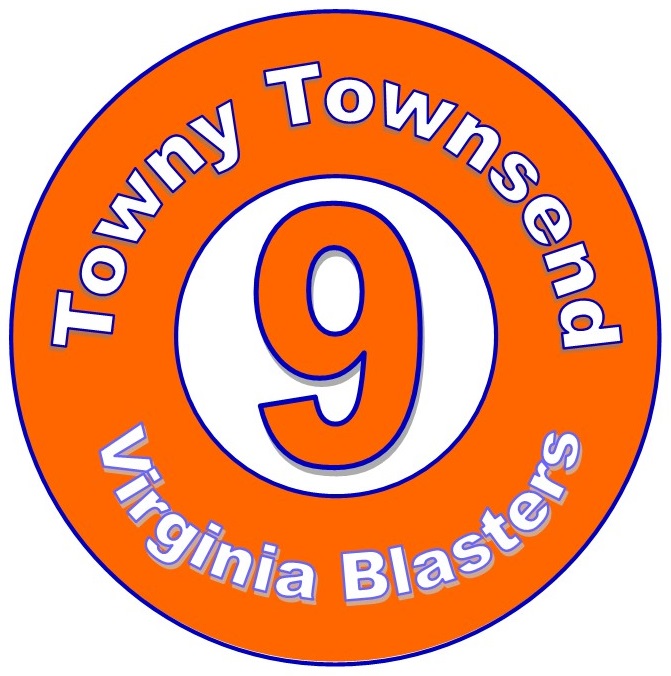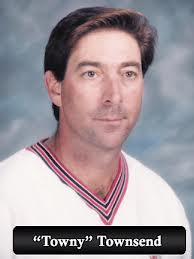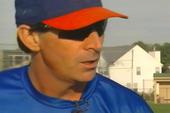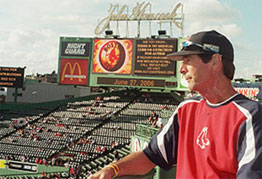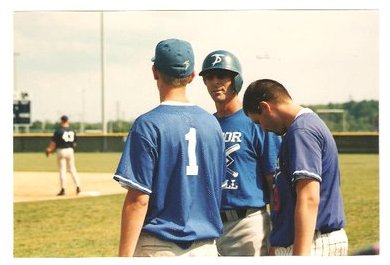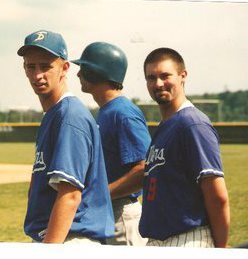This page is dedicated to the memory of the great baseball men who have influenced and supported summer baseball in the Tidewater area throughout the years.
HARRY POSTOVE
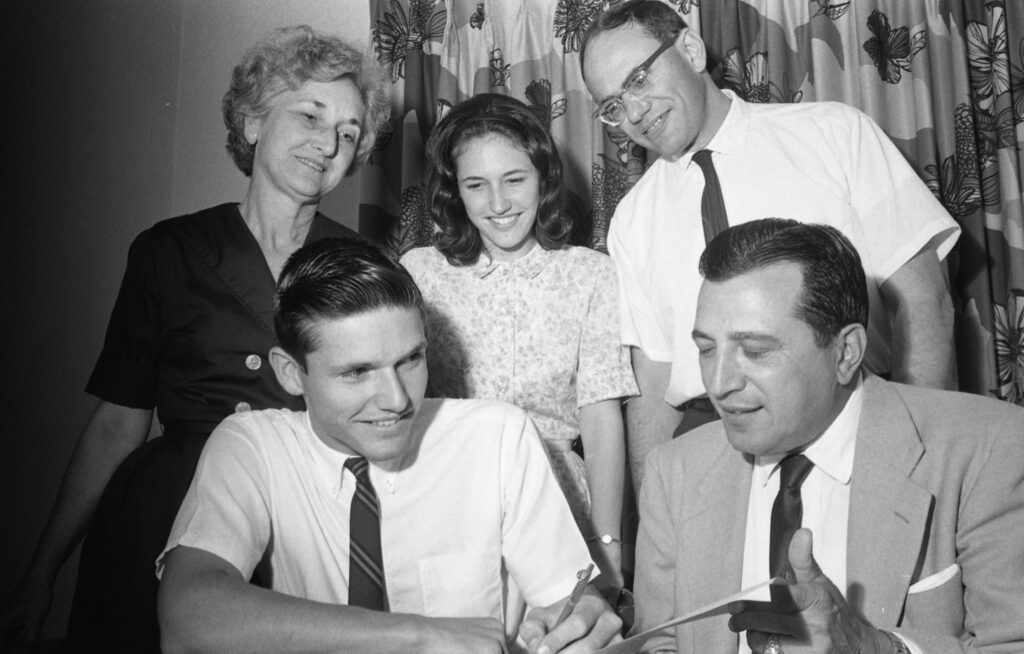
Harry Postove was instrumental in seeing the Norfolk City League come to fruition, and nurtured the league for over 50 years. Harry was a sports editor for the Norfolk Ledger, served his Country in the Military, and was a professional MLB scout.
Harry Postove helped shape, guide and support the Tidewater Summer League from it’s inception in 1946 through his death in 1999, and the league named it’s annual post season championship tournament in his honor, the Harry Postove Memorial Championship Tournament, and our clubs now compete each year for the prestigious Postove Cup, awarded each year to our league’s champion.
The following was taken, with permission, from Harry’s nephew, Joe Postove’s social media page.
“My Uncle, Harry Postove died 20 years ago today at the age of 86. This was a shock because he was supposed to live forever. That was my plan.
Harry never married. Judaism, the YMCA, and Baseball was his wife (life). He would get up every morning (I lived in his house in the 90’s) and go to shul, come home, eat breakfast, take a nap, get a schpritz at the Y and winter, spring, summer and fall, the rest of the day was baseball.
Yes, even in the midst of winter he would go see baseball coaches and talk about what might be coming up. When he was younger and worked full time, he spent the winter in Cuba and South America, looking for talent.
Uncle Harry was a sports columnist for the old Ledger-Dispatch, the manager of the baseball team on the Naval Air station in Norfolk during the war (when the service teams had more major leaguers than the bigs) and then spent 52 years as a scout, traveling the east and mid-west six month out of the year. I once asked Harry how many games did he think he had seen in his life? His answer was “I don’t want to think about it”. He HAD seen enough. But there was always more.
Those who knew him well could see that through his gruff exterior was a pussycat. He would kill me for saying that if he weren’t already dead. When his brother (my Father) died in 1993, I saw this man who didn’t show his innermost emotions, fall and cry like a baby. He never told me he loved me, but I know he did. I never heard him say I love you to anyone, but he loved his family and friends and was loved back in kind.
It was only on his last birthday that I gave him a kiss. He didn’t fight me.
He had more gentile friends than Jewish ones, and would explain to them that “he had Church on Saturday” and couldn’t come out on Shabbos morning. He was my Hank Greenberg and Sandy Koufax.
When I went into his office the day after he died, I found all of his notebooks and paraphernalia ready for the 1999 season. A season, though he was 86, he shockingly would not attend.
You see, Harry was such an institution, that it was dislocating for his friends and fellow baseball people NOT to see him, wearing his fedora, sitting in his lawn chair, stopwatch at the ready, where he had always been; at another game, looking for the next
Luis Aparicio (hall of famer who he discovered).
Until a week before he died, he observed his routine.
I think about him every day. He could argue sports all day. But I got to know the softie Jew who loved his religion AND the YMCA.
And baseball….forever baseball.
And me. Lucky me.”
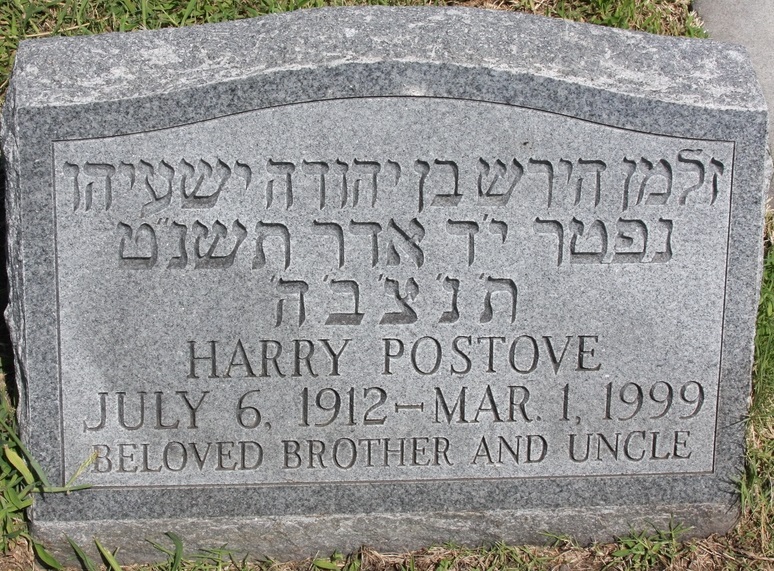
.
COACH T – Towny Townsend
For those of us who had the privilege to know and take the field with Coach T, he is missed but will never be forgotten. For those who did not, I have included some articles that had been written that we wanted to share with everyone.
LATE IN the afternoon of June 18, 2006, a routine Sunday on the major league calendar, the Minnesota Twins’ Michael Cuddyer, the Washington Nationals’ Ryan Zimmerman and the New York Mets’ David Wright batted in rapid succession. They were playing in different games in different cities, but anyone who had MLB’s Extra Innings package and nimble fingers on the remote could see every pitch. ¶ Marvin (Towny) Townsend was sitting on his couch in Chesapeake, Va., five years into a fight with throat cancer. He had lost half of his tongue, part of his esophagus and the use of his left arm. Now the cancer was making its way toward his lungs. One of the few things he could still do was channel surf. He watched Cuddyer stroke a single to center. Then he saw Zimmerman hit a game-winning home run. After Wright came through with a single of his own, Townsend turned to his older son, Sean, and shouted in a gravelly voice: “This is the best thing ever!”
Townsend, who coached high school and college baseball in Virginia for 30 years, died 10 months later at 54, survived by his wife, two sons and a legion of major league players from Chesapeake and the bordering town of Virginia Beach. Six of them—Wright, Zimmerman, Cuddyer, the Tampa Bay Rays’ B.J. Upton and the Arizona Diamondbacks’ Justin Upton and Mark Reynolds—are burgeoning stars. And except for Zimmerman, all play for teams in the mix for playoff spots. If Townsend were alive today, he would need more televisions.
Chesapeake and Virginia Beach, part of the coastal region of Virginia formerly known as Tidewater and now called Hampton Roads, may be America’s most unlikely baseball hotbed. The combined population of the two cities is less than 700,000. Locals like to say that the temperature in the winter can drop from 70° to 20° in a matter of hours, making it difficult to schedule games year-round. For much of the 20th century, the most notable major leaguer from the area was Washington Senators lefthander Chuck Stobbs, famous mainly for giving up a 565-foot home run to Mickey Mantle in 1953.
“For a long time this was a place you could ignore,” says Billy Swoope, who scouts the Mid-Atlantic for the Chicago Cubs and is the majors’ only full-time scout based in Hampton Roads. “It was completely barren.” (The area, which also includes Newport News, Hampton, Norfolk, Portsmouth and Suffolk, has long been known for producing pro football and basketball players, including Kenny Easley, Bruce Smith, Michael Vick, Alonzo Mourning and Allen Iverson.)
Townsend believed that his favorite sport needed a lifeline. So in 1992 he launched the area’s first AAU baseball program, which came to be called the Virginia Blasters after Townsend’s adult-league team. Needing opponents, he persuaded his friend Gary Wright to launch a rival program, the Tidewater Drillers. Cuddyer, David Wright and the Uptons played for the Blasters. Zimmerman played for the Drillers. Reynolds played for both. From 1997 through 2005 those two AAU programs produced five first-round draft picks, a tide unlike any the area had ever seen.
Scouts were dumbfounded. Baseball talent is typically abundant in Southern California, Florida and Texas, not clustered in a small corner of southeast Virginia. But here were six future major leaguers, living no more than 20 miles apart, hitting at the same batting cage, working out at the same gym, sometimes playing on the same field. They knew each other’s parents and prom dates. If a scout went to see one, he would wind up catching four or five.
“Sometimes the stars just line up, and it’s hard to explain why,” says Reynolds, now 25 and the Diamondbacks’ third baseman. “It’s a pretty incredible thing. But without Coach Townsend, I really don’t think any of it ever happens.”
GROWING UP in Philadelphia, Townsend learned to hit by swinging at bottle caps with a sawed-off broomstick. His father would sit on a picnic table and fling the bottle caps through the air, letting the breeze blow them in different directions, like knuckleballs. When he began coaching, Townsend used the same hand-eye drill with his players, except he traded the metal bottle caps for plastic coffee lids, believing they better withstood the punishment. He could toss the coffee lids from all angles, making them duck and dive like curveballs and sliders.
After his junior season at Campbell University in 1974, Townsend was drafted by the Boston Red Sox; he spent two years in the minors and then became the baseball coach at Virginia Wesleyan College in Norfolk. “Right when I got there he had us take batting practice with those coffee lids,” says Matt Sinnen, Townsend’s first recruit at Virginia Wesleyan. Townsend reasoned that if a hitter could make solid contact with the narrow edge of a coffee lid, he would have no trouble squaring up a baseball about eight times as thick.
Over the next three decades Townsend experimented with every conceivable brand of plastic lid, trying to find the one that best mimicked the flight of a baseball. When Cuddyer, now the Twins’ rightfielder, and Wright, the Mets’ third baseman, were in elementary school and started taking hitting lessons with Townsend, he pitched them Cool Whip lids. “It’s how we all learned to hit,” says Wright, 25. “I didn’t know it was different from what they were doing anywhere else. I thought everybody was hitting lids.”
Cuddyer was the oldest of the group, by nearly four years, and by the time he was 11 Townsend was introducing him as a “future professional baseball player.” Townsend knew that his star pupils had potential but worried they would not get enough training in the local youth leagues, so he began to expand the Blasters program. In 1993 Townsend had only a 14-and-under squad led by Cuddyer, so he talked two of his adult-league teammates, Manny Upton and Allan Erbe, into coaching a new 11-and-under team that would include Manny’s nine-year-old son, B.J. (Manny’s six-year-old son, Justin, was not old enough to play and served as the batboy.)
B.J. Upton played second base for the 11-and-under Blasters, and Wright played shortstop, a middle infield with terrific upside that wasn’t yet apparent. B.J. was so skinny that coaches constantly ordered him to bunt, fearing that he could not muscle the ball to the outfield. Wright, on the other hand, was so pudgy that opposing coaches told each other, “We can take advantage of that chunky shortstop.” Whenever the Blasters hit the road, they took with them a bag of baseballs and a bag of Cool Whip lids. If it rained, players retreated to their hotel and found a conference room where they could hit the lids.
The Blasters did not charge dues—the team raised money through fund-raisers and other donations—but they did have contracts, mandating that every player maintain at least a 2.5 grade-point average. Townsend scouted youth leagues for talent, and Erbe wrote playbooks filled with diagrams and explanations on how to cover bunts and defend first-and-third situations. Wright often complained that Erbe spent too much time on defense, but years later, when Wright was in the Mets’ farm system, Erbe received an e-mail from the address Met3Bagger. It read, “I play well off the line and I run a lot of coverage 2,” a direct reference to one of the Blasters’ bunt defenses.
By 1994 the Blasters had six teams, one for each age group from nine through 14. B.J. Upton, who had been playing with kids two years older, moved down a year to team with Reynolds, the lanky infielder with huge hands whose family had moved to Virginia Beach from Kentucky. Reynolds had initially signed on with a rival league, whose president soon took Reynolds out of his age group; the league official was concerned about “the safety of other players” because Reynolds was hitting the ball too hard for anyone else his age to catch it.
Townsend was building a powerhouse, and he tried to lure Sinnen, his former player at Virginia Wesleyan, to coach one of the teams. But Sinnen wanted a challenge and opted to coach for the Drillers instead. His best player was a soft-handed shortstop from Virginia Beach who had slipped under Townsend’s radar. Zimmerman was the smoothest fielder in Hampton Roads, but he had a hard time putting on weight and a lot of coaches assumed he would not be able to generate power. “I offered to throw him a party if he could ever crack 100 pounds,” says Zimmerman’s father, Keith.
When Ryan Zimmerman was 10, in his first season with the Drillers, he went 27 for 32 in an AAU tournament in Kansas City, Mo. When Wright was 12, he hit seven triples in a doubleheader in Manassas, Va. And when B.J. Upton was 16, facing Drillers ace Justin Jones, he hit a 92-mph fastball off Jones’s left forearm, sending him to Sentara Leigh Hospital in Norfolk with a bone bruise.
Stories about the boys started to sound like myths. “We grew up,” says B.J. Upton, now 24 and the Rays’ centerfielder, “by pushing each other all the time.”
IN 1997 the Twins drafted Cuddyer with the No. 9 pick, making Townsend’s earliest prediction come true. Wright, Reynolds, Zimmerman and the Uptons were not even in high school yet, but they understood the significance. From then on, scouts would have to stop by Hampton Roads in case another Cuddyer came along. “I remember telling myself, I want to do the same thing he did,” says Wright.
By the time Wright turned 16, his baby fat had turned to muscle and he had developed the swing he uses today. In the 1999 AAU national championships in Cleveland, he hit a 400-foot rocket over the centerfield fence that slammed into an old oak tree. As Wright rounded the bases, a six-foot branch fell from the tree and landed in somebody’s backyard. Video of the blast, taken through a chain-link fence, became an underground favorite in Chesapeake. Ron Smith, who coached Wright’s team along with Erbe, watched the grainy footage again last month and said, “Just like Roy Hobbs.”
The future big leaguers all knew each other, but because of age differences and AAU affiliations, no more than two of them had ever played on the same team. But in 2000 a Virginia Beach coach, Lee Banks, put together a fall showcase team called the Mets, finally bringing the group together. It was one of the greatest collections of teenage talent ever assembled. The roster included Wright, Reynolds, Zimmerman and B.J. Upton. Justin Upton, still too young, was a pinch runner. For the first time they were neither Blasters nor Drillers; they were representing Hampton Roads, finishing the work that Cuddyer started. “Nobody,” says Cuddyer, 29, “is more proud of those guys than I am.”
![]()
For Banks, the hardest part of managing the team was filling out the lineup card. Because all the players were shortstops, Banks had to rotate them among shortstop, second base and third base. It was good training for the future, when Wright, Reynolds and Zimmerman would become third basemen, and Cuddyer and both Uptons would move to the outfield. The Mets played 25 games, traveling up and down the Eastern seaboard, passing time by picking on Justin Upton. “We made fun of him because he was the smallest,” says Zimmerman, who turned 24 on Sept. 28. “Now he’s bigger than all of us.”
By 2003 Reynolds and Zimmerman were at the University of Virginia, Wright and B.J. Upton were in the minor leagues, and Justin Upton was at Great Bridge High in Chesapeake. From the time Justin was 10, playing for the Blasters, he was drawing intentional walks as if he were Barry Bonds. The Diamondbacks drafted him No. 1 in ’05, and two years later, just before his 20th birthday, he joined the rest of the group in the major leagues. They studied each other’s batting lines nightly. At the ’06 All-Star Game in Pittsburgh, as Wright prepared for the Home Run Derby, he received a text message from B.J. Upton: DON’T EMBARRASS THE AREA. Wright pounded 16 home runs in the first round.
The players’ parents would see each other around town, at the post office or the grocery store, and shake their heads in disbelief. This year, when the Diamondbacks played the Nationals in Washington, the Upton family sat with the Reynolds family, watching their sons’ team play against Zimmerman’s team—Blasters-Drillers all over again. “It was really weird,” Manny Upton says. “We looked at each other like, Haven’t we been doing this since they were 10?”
SINCE TOWNSEND’S death the Blasters have all but disappeared—only one team, 13-and-under, remains—while the Drillers have taken control of the area. Sinnen, still a Drillers coach, has a term he uses when one of his infielders makes a particularly nifty pickup. He calls it a “Zim play.”
Although Zimmerman will be idle this October, his buddies hope to still be playing. Wright, Reynolds and both Uptons are in position to make the playoffs. Cuddyer, recovering from a broken foot, is hoping to join them. No matter the outcome, they will meet back home afterward. They still work out together in the off-season at Fitness 19 in Chesapeake, hit the batting cages at Grand Slam U.S.A. in Virginia Beach, play in each other’s charity golf tournaments and talk about where they will watch the Virginia–Virginia Tech football game. Wright throws a holiday-birthday party at an area lounge and pays for a block of hotel rooms to make sure no one has to drive home afterward.
“Nothing has changed that much,” says Wright. “We still do everything together.”
Their club is growing. Other major leaguers from Hampton Roads include relievers Clay Rapada, 27, of the Detroit Tigers; Josh Rupe, 26, of the Texas Rangers; and Bill Bray, 25, of the Cincinnati Reds. Prominent minor leaguers include first baseman–outfielder Jason DuBois, 29, of the Cubs; righthander Justin Orenduff, 25, of the Los Angeles Dodgers; infielder Matt Smith, 25, of the Mets; and lefthander Justin Jones, 24, of the Nationals (the same Justin Jones whom B.J. Upton struck on the forearm eight years earlier). Townsend followed all of them on the Internet, jotting their stats in a notebook alongside Cuddyer’s and Wright’s and Reynolds’s and Zimmerman’s and the Uptons’.
Townsend died at the beginning of the baseball season, in April 2007, so his players mourned from a distance. They reminisced about his joyful spirit (he once walked onto the field with a snorkel and a rubber duck and soaked his team with a water gun), his notorious temper (he was ejected from games as a player, manager, fan and parent), and his creative ways to help young people learn. A statement from Wright, read at the funeral, began, “I could go on for days about what Coach Townsend has taught me.”
Walk through the front door of the Townsend house, and you are greeted by a quote from Babe Ruth, painted above an interior doorway: I WON’T BE HAPPY UNTIL WE HAVE EVERY BOY IN AMERICA BETWEEN THE AGES OF 6 AND 16 WEARING A GLOVE AND SWINGING A BAT. The quote pretty well sums up Townsend’s life mission. “I painted it,” says his widow, Cathy, “but it’s hard for me to look at sometimes.”
In his final months Townsend thought a lot about bottle caps and coffee lids. He could not coach much anymore, but he could still help the next generation hit. So he met with a NASA engineer to design his own plastic lid, flexible enough that it would not break, aerodynamic enough that it would not flutter. He called it the Towny Townsend Hitting Disc and found a plastics company in Suffolk to manufacture it in bulk. Cuddyer and Wright helped him film an instructional DVD. When Townsend died, there were still 20,000 discs sitting in his garage.
Cathy did not want to keep them and did not want to throw them away, so she followed through on her husband’s plans to sell them online (hittingdisc.com)—50 discs to a bag. She has been selling them ever since, as many as nine bags per day. Most of her orders come from California, Florida and Texas, with some from as far away as Australia. Now only a few boxes are left in the garage, and Cathy is getting ready to order more. “I’d like this to be part of his legacy,” she says.
Her younger son, Chase, is 22 and helping her with the business. Sean is 26 and coaching the junior varsity baseball team down the road at Great Bridge High. Last season Great Bridge played a game at nearby Western Branch High, and as the team bus pulled onto the Western Branch campus, a handful of kids were assembled on a patch of grass. Great Bridge players pointed at the kids and then motioned to Sean. “Look! Look!” they chirped. Sean glanced out the window and saw his father’s vision sprung to life. The kids were hitting Towny’s discs.
By Tom Robinson
The Virginian-Pilot
VIRGINIA BEACH – Baseball coach Towny Townsend was celebrated in many ways Saturday afternoon: as a “hero” by family members, as a “mentor” by former players, and as “a cool dean” of discipline to whose office Norfolk middle-school students actually asked to be sent.
The thread that joined each testimony during a two-hour funeral, however, was Townsend’s “example” of a life richly lived.
“He made you want to be better,” Townsend’s nephew, Justin Cotterell, 23, said of his uncle, who died Wednesday at age 54. “And the world needs more people like that.”
Approximately 600 people filled the sanctuary of Kempsville Church of Christ, adorned with baseball-shaped floral arrangements – the one atop Townsend’s casket bore his uniform No. 9 – to hear that sentiment. Nearly two dozen of them shared personal stories of the powerful influence Townsend had upon them, and also upon local amateur baseball.
Most, such as Matt Sinnen, who played for Townsend at Virginia Wesleyan College in the 1970s, stepped to the pulpit:
“Everybody wanted to be Towny Townsend,” Sinnen said. “Tall, dark and handsome. He was the best at everything he ever did.”
Others unable to attend sent written messages. One salute, from New York Mets All-Star third baseman David Wright, was originally read by Townsend’s wife, Cathy, at Tuesday’s Norfolk Sports Club Jamboree, where Townsend received a lifetime achievement award.
When Townsend died the next day, Wright’s words gained poignancy:
“I could go on for days about what Coach Townsend has taught me on the field,” Wright wrote, as read by Townsend’s sister Beth Mills. “But the lesson that stuck by me… is the work ethic and necessary heart it takes to not only succeed on the diamond, but in life. I’m personally thankful for men like Coach T every time I take the field.”
Townsend, a star infielder at Lake Taylor High who played in the Boston Red Sox organization, is considered the spark behind South Hampton Roads’ evolution as fertile soil for professional baseball prospects. While coaching at Lake Taylor in the early ’90s, Townsend founded a year-round baseball program called the Blasters to provide better young players more opportunity to play against top competition.
While that led to the formation of many similar programs, through the years Townsend’s Blasters turned out such players as Wright, Minnesota Twins outfielder Michael Cuddyer, Tampa Bay Devil Rays infielder B.J. Upton and Justin Upton, the nation’s No. 1 draft pick in 2005.
Townsend later also coached at Greenbrier Christian Academy in Chesapeake, where he won the state private-school championship. He was diagnosed with throat cancer in 2001, however, and spent the ensuing years battling the disease with a fire that was widely admired.
Townsend’s passion for Cathy and their sons Sean and Chase, for baseball and for building character in his students was always on the surface, friends related. One, Ron Smith, recalled Townsend’s sheepish boast about being perhaps “the only person to be thrown out of a baseball game as a player, as a coach, as a parent, and as a spectator.”
It was that intensity, noted by an array of mourners, that moved Townsend to rescue troubled teens at all hours of the night. To challenge students and players to expect more from themselves. To inspire them in life-changing ways.
And to remind everyone, with a favorite quote expressed by Mills, that “talent is God-given; be thankful. Fame is man-given; be humble. Conceit is self-given; be very careful.”
To the Rev. Randy Childress, the way Townsend modeled love, discipline and perseverance, especially during his long struggle, will endure as his most lasting lessons.
“Don’t make people just admire you,” Childress said. “Make them glad you were here.”
CONGRATULATIONS TOWNY! “Towny Townsend to receive Bud Metheny Award on January 26th, 2007″ Towny Townsend has coached or instructed 23 professional baseball players during his career; most notably present major leaguers Mike Cuddyer (Minnesota Twins), David Wright (New York Mets), Jason Dubois (Cleveland Indians) and B.J. Upton (Tampa Bay Devil Rays). Towny has accomplished all this while experiencing personal and physical hardship with the passing of both parents and suffering through 3 bouts with cancer.
Coach Townsend was drafted three times professionally as a player before signing with the Boston Red Sox in 1973. He founded the very first baseball camps in the state of Virginia and is referred to as the founding father of travel baseball in Virginia. Coach Townsend has been an NCAA division three national coach of the year finalist, state high school coach of the year and conference coach of the year 9 times. During his 43 years of baseball experience, many things have remained constant for Towny – his love for his wife Cathy and two sons, Sean and Chase, his love for coaching and the use and constant development of the games and drills for what is now referred to as the Towny Townsend Hitting Disc. Towny is presently undergoing chemotherapy treatment to battle lung cancer and has taken on the battle of defeating the disease for all in his lifetime. A portion of the proceeds will aid Coach Townsend and other cancer patients by contributing to the American Cancer Society. Another portion of the proceeds will benefit the David Wright foundation helping in the battle against MS.
The Towny Townsend Hitting Disc is the creation of legendary Virginia baseball coach Towny Townsend and has been used by Towny and his teams for over 40 years. The Hitting Disc is an excellent hitting tool that has been proven and tested over thousands of hours and is now available for every ball player who wants to become a better hitter. The Hitting Disc is a great targeting and tracking tool and excellent for developing proper swing mechanics, bat speed and outstanding hand/eye coordination. The Hitting Disc is safe and easy to throw allowing for any member of the family to throw quality hitting practice without the need for L-screens and batting helmets and they take the fear out of being hit for players just starting out in the game. The Hitting Disc can be used outdoors but makes for a fabulous indoor training. The Hitting Disc can simulate all types of pitches by simply varying the angle of the wrist while throwing.
